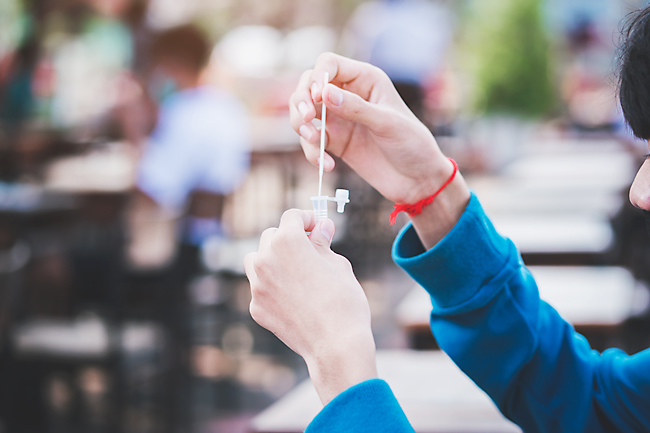Hakim Hayat
As the Sultanate comes to terms with the endemic nature of COVID-19, getting tested for the virus is now as easy as going to a pharmacy to buy a self-test kit that delivers results within 10-15 minutes.
An antigen rapid test (ART) detects SARS-CoV-2, the virus that causes COVID-19. It is easy to do and safe, with fast results.
An ART kit is a quick screening tool which can be self-administered, especially for individuals worrying that they may have or were exposed to COVID-19 and wishing to put their minds at ease.
The ART kits can be purchased at community retail pharmacies, general retail shops and e-commerce platforms.
A list of authorised self-test kits issued by the Ministry of Health (MoH) can be found on its website.
The MoH has also appointed 12 clinics and healthcare companies to operate as ART certification centres for individuals requiring certificates as proof that they have been tested, for entry into public venues.

The self-test kits do not require users to insert the swab as far into the nose as the professional swabbers do in a polymerase chain reaction (PCR) test. The swab only needs to touch the nasal passage about two centimetres inside the nostrils, or what is known as the anterior nares.
The tests work best in the early stages of infection, with a sensitivity of about 80 per cent for cases with higher viral loads. Nonetheless, they have been useful in enabling faster detection of possible cases as results can be obtained within 30 minutes.
However, under the hands of an untrained individual, there might be a higher chance of false negatives emerging due to an incorrect sample preparation or testing process. Hence it is important to read the instructions carefully.
An individual invited by the MoH or other authorities to undergo an ART screening must follow the ministry’s instructions on the testing requirements, according to the MoH.
On the other hand, if the individual wishes to self-administer the test, please ensure to follow the ART usage instructions carefully.
For individuals with acute respiratory infections such as fever, cough, flu, sore throat or runny nose, they are encouraged to stay home and perform an ART test. If the symptoms worsen, get immediate medical attention at the nearest flu clinic.
For those who had a nosebleed in the past 24 hours, nasal surgery in the last four weeks or facial surgery in the last eight weeks, they must not perform the test screening at home.
The variety of test kits available in the market today usually comes with similar components such as a swab, test strip and buffer solution in a tube.
The instructions to use the test kits may vary slightly, depending on the designs. It is best to refer to the instruction sheets provided by each manufacturer.
Before performing the test, the user must ensure to conduct it in a well-ventilated room away from others; find a flat surface to place the cartridge, use a mirror and a timer as guides; and ensure the surfaces used can be easily cleaned and wiped down (for instance your bathroom).
HOW TO PERFORM THE TEST
Clean your hands before performing the test.
Swab both your nostrils. Insert the swab about two centimetres into one nostril and rotate the swab five to 10 times against the inside wall of the nostril. Using the same swab, repeat the previous swab for the other nostril.
To proceed with the results, refer to manufacturer’s instructions.
In most cases, you need to insert the swab into the tube, swirl it in the fluid 10 or more times while pushing it against the tube wall.
Pinch the swab tip through the tube walls to remove any remaining fluid. Leave the swab in the tube, and secure the top of the tube with the cap provided. Draw two to three drops on the testing cartridge.
Read and check your own ART results according to the instructions. If your result is positive or invalid, ensure that you have taken a photo of your result with your identification proof next to it before disposing it.
Most kits require a 15-minute waiting period before the results can be read. They also indicate that the virus is detected if two lines appear – the control (C) line and the test (T) line.
DISPOSE OF THE USED TEST KIT AS INSTRUCTED
After reading the results, bag all the used items in the test kit into one plastic bag or sealable bag and seal it tightly. Place the tightly sealed bag into another plastic bag. Tie the second plastic bag with a rubber band or cable tie.
Ensure that the bags are lightly tied to protect others in your community. Throw the plastic bag into a pedal rubbish bin immediately.
Clean the surfaces such as table used for the test with soap and disinfectant products. Wash your hands using soap and water or hand sanitiser after you are done.
Stay safe! Call the Health Advice line at 148 to seek further advice if you have a positive test or two invalid tests.
Stay vigilant, continue to observe self management measures, and monitor your health if the result is negative.
WHAT IF YOUR RESULT IS POSITIVE?
Stay calm. Take a photo of your ART test result(s) with your identification documents (smart card/passport) in the same photo immediately before disposing it.
Visit the nearest swab centre immediately, in your own transportation, to undergo a polymerase chain reaction (PCR) test.
Bring your identification document and show the photo of the ART test results.
After completing the confirmatory PCR test, self-isolate at home immediately until you receive your test results.
If your PCR test is positive, continue to self-isolate at home while waiting to be contacted by the MoH within 24-48 hours. You will then be provided with instructions for follow-up actions.
If you experience severe symptoms such as high fever, shortness of breath, weakness, vomiting, diarrhoea and no appetite, call the emergency line at 991 immediately.






